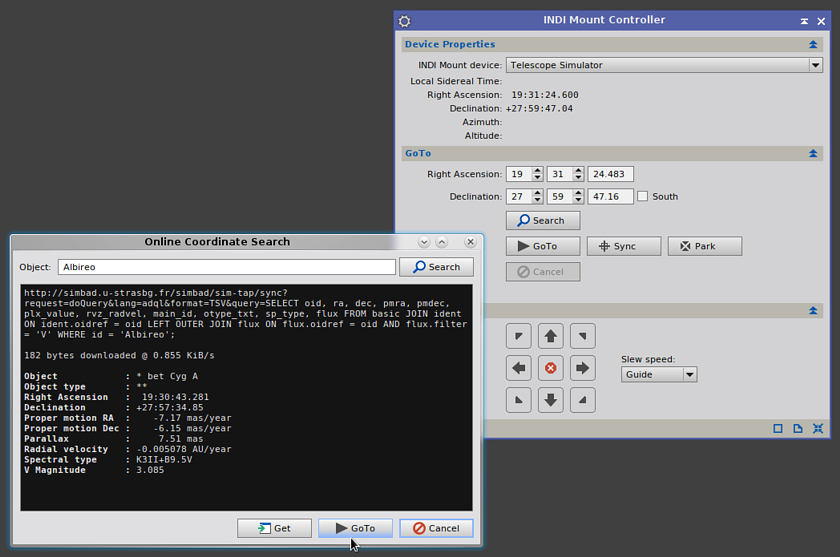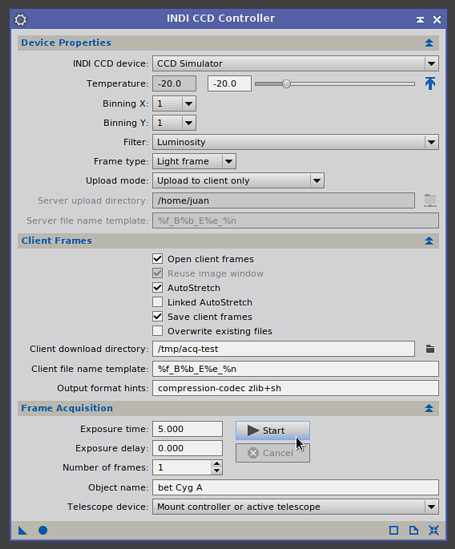Hi all,
Today we have released a new version of the INDIClient PixInsight module: 1.0.15, now available as a regular update for PixInsight 1.8.4 on FreeBSD, Linux, OS X and Windows.
This version comes with an exciting new tool: INDIMount. This tool allows you to control your telescope with features such as online catalog search, GoTo, Slew, Sync and Park functions, high-accuracy mean/apparent coordinate transformations, differential position corrections, fully scriptable process, and more. The new version also includes bug fixes and stability and performance improvements in the rest of INDIClient tools: INDIDeviceController and INDICCDFrame.

INDIMount is really straightforward to use, as you can see in the above screenshot. However, there is much more under the surface that what you might expect from the simplicity of its user interface. One of our main goals with the development of these tools is to achieve the highest possible pointing accuracy. While our efforts can be clearly excessive to control small telescopes, they can be quite important for large telescopes and modern high-quality mounts, and are essential for the next generation of tools that we have planned within the INDIClient project. This includes generation and integration of astrometry-based pointing models, among other tasks.
When you search and select an astronomical object with the Online Coordinate Search dialog (see above), INDIMount computes the apparent position including corrections for proper motions (when available), stellar aberration, precession, nutation, and frame bias. The resulting apparent geocentric coordinates populate the coordinate fields on the GoTo section, and are sent to the selected INDI mount device for GoTo and Sync operations. Apparent coordinates are computed using accurate, rigorous algorithms. Our implementation is based on the
IAU SOFA software library. In the current implementation we are not computing the corrections for parallax and radial velocity (which are very small in most cases; the largest parallax is smaller than 0.75 arcsec), and we are neglecting the effect of light bending. In the next version we'll include calculation of topocentric coordinates (which can be relevant for observation of near-Earth objects and the Moon), the effect of atmospheric refraction (very important, but neglected in this initial version for simplicity), and calculation of solar system ephemerides (using an integration of JPL development ephemerides with the PixInsight/PCL platform).

INDIMount and INDICCDFrame work cooperatively. When you acquire new client-side images and a telescope device is available (see INDICCDFrame's telescope device parameter), it is used to retrieve its current EOD (epoch of date) coordinates just before each exposure. These apparent coordinates are converted to ICRS J2000.0 mean positions by an inverse transformation. Once these coordinates are computed for each acquired image, they are stored as standard XISF properties (Observation:Center:RA and Observation:Center:Dec). For compatibility with legacy applications, as well as with tools and scripts still performing the transition from FITS keywords to XISF properties, the same coordinates replace the OBJCTRA and OBJCTDEC keywords provided by the INDI server.
The main advantages of this process are: (1) we always store mean J2000.0 positions in newly acquired images, which are directly comparable between different images and stellar catalogs, irrespective of the times of observation, and (2) we compute apparent and mean positions using very accurate and rigorous algorithms (IAU 2006 precession/nutation model and a rigorous stellar aberration model). As noted above, this is necessary for the implementation of future tools, including generation of pointing models.
INDIMount also has a very nice feature: differential pointing correction. To use this feature, follow this sequence of operations:
- Point your telescope to a desired location with INDI Mount Controller.
- Acquire an image with INDI CCD Controller.
- Solve the image astrometrically with the ImageSolver script.
- Launch a new instance of INDIMount (you know: INDI Mount Controller, click blue triangle, drag) to the image.
With this sequence, INDIMount will compute the difference between the observation coordinates (where the telescope
thinks it's pointing to) and the actual pointing coordinates, then this difference will be applied to move the telescope from its current location. This feature is very useful to perform quick pointing corrections and/or to synchronize your mount at a known location.
Our next goals with the INDIClient project are:
- Improve the INDIMount and INDICCDFrame processes.
- Pointing model generation and integration.
- Autoguiding.
- Autofocus.
So stay tuned! As always, a huge thanks to Klaus Kretzschmar for his work on this project, to Vicent Peris for great development ideas, to the INDI developers for making all of this possible, and to all the users and friends that enthusiastically support us.